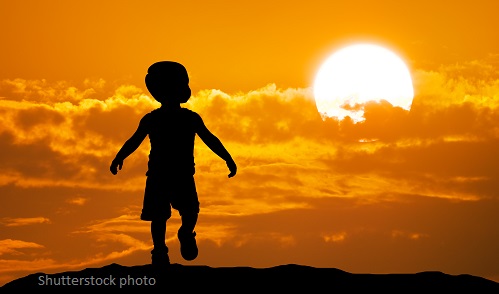|

Bye-Bye Big Ball
by Andrea Cameron
Our family loves to watch the sunset over the bay at our cottage on Prince Edward Island. One evening, my husband and I sat on either side of our two-year old son, Kieran. Having just finished his bath, Kieran was wrapped in a fluffy towel, his hair a mess of wet curls. Suddenly, our joyful toddler waved at the brilliant orange sun resting on the horizon and exclaimed in his most passionate voice,“Bye-bye big ball!”
A few nights later, Kieran woke at 3:00am shouting again about the big ball he could see clearly through the skylight above his bed. My husband explained that this particular “big ball” is called the moon. No matter where we took Kieran in the cottage to try to get him back to sleep, he seemed to find the moon through a window. He chattered enthusiastically about his discovery until 5:00am. While the timing of this astronomical epiphany exhausted us, his excitement was infectious. Bleary-eyed but smiling, my husband commented how amazing a full moon must look when seeing it for the first time. If it weren’t for our nocturnal toddler, we likely wouldn’t have noticed the full moon at all.
This made me think about how little we see the night sky, how little we are connected to the rhythms of nature. Our children need this connection for their physical, spiritual, and intellectual development. I want Kieran to retain his innate sense of awe for the natural world. However, after a decade of teaching high school, I wonder why this often disappears by adolescence.
I have an idea why. As an educator, I perpetuate the environmental doom and gloom we inflict upon our students in an effort to shock them from complacency. While rainforest destruction and melting glaciers trouble us all, fear detracts from environmental protection. The rainforest remains an abstraction to children and youth. Instead, an intimate connection with the ecosystems in backyards, parks, and surrounding wild spaces builds the foundation for authentic stewardship. Unstructured outdoor play provides children with an intimate understanding of their local environment, be it urban, rural, or in between.
A few years ago, I conducted an experiment with one of my English classes. I made twenty flashcards. Ten of the cards depicted local bird species such as seagulls, blue jays and sparrows. The other ten cards featured corporate logos. All of the students in my class were able to correctly identify each of the corporate logos; however, the highest score for the bird identification was four. The student who correctly identified four local birds was actually an exchange student from Eastern Europe. I discussed with my class how much time they spent outside. Most of them admitted that getting on and off their school bus constituted their only daily outdoor time.
If children care about the fish in a local stream, a melting ice shelf in the High Arctic resonates more deeply. Furthermore, playing outside allays concerns about too much screen time. As I watch Kieran try to balance tiny pebbles on the leaves of a plant, I am certain this focused exploration of physics stimulates his developing nervous system better than watching a sterile, animated version of nature on television. By carving out some precious time from our busy schedules to be outside, we make room for wonderment in our children’s lives.
I love to watch Kieran run in the surf, lifting his toes high out of the sea foam. I hope I will always remember his wide-eyed surprise when an osprey plunged into the water and emerged with a wiggling fish as we sat on the beach. I’ve reconnected with nature myself as I watch him dig in the sand with half a clam shell or drop to the ground mid-step to watch an ant navigate over a dirt road. I hope that even when life gets hectic, we will make time for the birds, the shells, and the ants. I hope we will always make time to watch the sunset and the moon rise.
Andrea Cameron is a mother and educator living in Eastern Ontario. This article was first published in Natural Child's sister magazine Natural Life.
|
|

